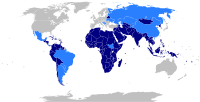
Photo from wikipedia
The coexistence of phylogenetically related species is an attractive topic because of the potentially intense interspecific competition. The most often investigated mechanisms mediating coexistence of these species are environmental filtering… Click to show full abstract
The coexistence of phylogenetically related species is an attractive topic because of the potentially intense interspecific competition. The most often investigated mechanisms mediating coexistence of these species are environmental filtering and niche partitioning. However, the role of other factors, such as species-specific parasites, is still poorly understood. Along the riparian understory of a tropical forest, we explored niche occupation and coexistence between Chrysso intervales and Helvibis longicauda, two related syntopic web-building spiders. We also investigated the effect of H. longicauda mortality induced by a specific fungus parasite, Gibellula pulchra, on the dynamic of C. intervales spatial distribution. Coexistence was mediated mainly by a fine-scale horizontal spatial segregation. H. longicauda built webs almost exclusively close to the river, while C. intervales occupied adjacent areas (10–20 m away from margins). We also found differentiation in other niche dimensions that might allow coexistence, such as in plants occupied, height of web placement, width of leaves used for thread attachment and phenology. H. longicauda mortality caused by fungi was higher during winter than in summer. Consequently, the abundance of C. intervales increased at distances close to the river, indicating competitive release through a density-mediated indirect effect. This demonstrates how non-competitive specific-antagonists can indirectly affect other non-hosts competing community members and influence their spatial distribution in fine-scale ranges. We suggest that environmental filtering restricts H. longicauda to cooler regions; niche partitioning leads populations to occupy different vertical strata and competitive exclusion precludes C. intervales to reach river margins, generating an unusual horizontal zonation pattern.
Journal Title: Oecologia
Year Published: 2018
Link to full text (if available)
Share on Social Media: Sign Up to like & get
recommendations!